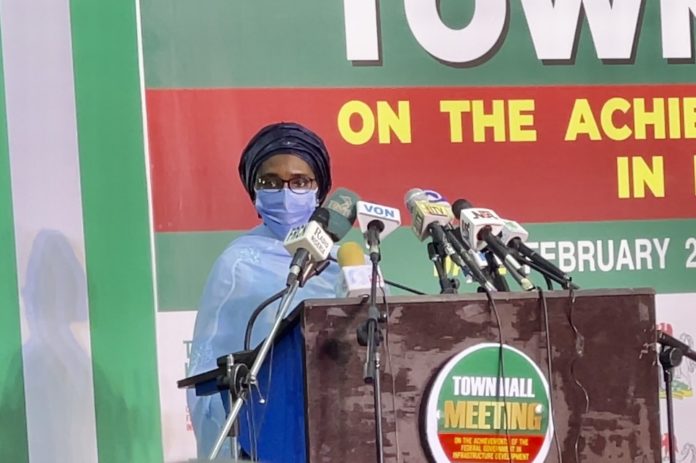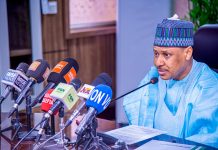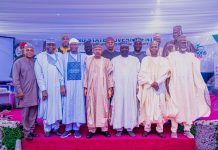SPEECH BY MRS. (DR.) ZAINAB SHAMSUNA AHMED, THE HONOURABLE MINISTER OF FINANCE, BUDGET AND NATIONAL PLANNING, AT THE TOWN HALL MEETING ON THE ACHIEVEMENTS OF THE FEDERAL GOVERNMENT IN INFRASTRUCTURE DEVELOPMENT
1. Good morning my colleagues, Honourable Ministers of the Federal Republic of Nigeria; distinguished ladies and gentlemen. I stand on all existing protocols. I am delighted to be here today at this Town Hall meeting to speak on the achievements of the Federal Ministry of Finance, Budget and National Planning and the Federal Government of Nigeria in infrastructure development in Nigeria.
2. Firstly, I wish to commend the Honourable Minister of Information and Culture and the Ministry for organizing and hosting this Town Hall meeting. It is indeed very important to sensitise the impacted communities, key stakeholders, the public and the nation on the infrastructure projects and programmes undertaken by this Administration to create the enabling environment for socio-economic growth and development.
3. Nigeria’s economy and population remain the largest in Africa with over $400 billion in GDP and over 200 million people. The country’s huge and growing population offer both an economic challenge and opportunity, in the light of constrained revenue proceeds brought on by several multi-dimensional factors, including the global pandemic and its impact on the domestic economy.
4. Against this backdrop of challenges, this Administration has successfully implemented a range of infrastructure programmes that have had a positive impact on the lives and livelihoods of the citizenry. During my presentation, I will highlight some of these programmes initiated by the Federal Ministry of Finance, Budget and National Planning, as well as those initiatives that the Ministry is helping to facilitate in other Ministries.
5. Before I proceed with these initiatives, I would like to use this forum to reiterate that good quality infrastructure is important, not only to engender and accelerate economic growth, but also to ensure and enhance inclusive growth for all within a nation space. Subsequently, this Administration continues to prioritize spending on infrastructure and human capital to catalyze rapid economic development. In 2022 alone, we plan to spend about N1.42 trillion on infrastructure and N2.11 trillion on human capital development.
THE ROAD INFRASTRUCTURE DEVELOPMENT AND REFURBISHMENT INVESTMENT TAX CREDIT SCHEME (RITCS)
6. The Road Infrastructure Development and Refurbishment Investment Tax Credit Scheme (RITCS) was launched in 2019 to leverage private sector capital and expertise to construct, repair and maintain critical road infrastructure in key economic corridors and industrial clusters in Nigeria.
7. The RITCS scheme is designed to complement and ameliorate the burden of funding significant capital outlays on road projects by the Federal Government. As a model, the RITCS adopts the use of tax expenditures, via tax credits, to finance the construction of critical road and bridge infrastructure projects, while utilizing an innovative PPP mechanism that is aimed at the incentivisation of private sector participation and capital investments.
8. The Scheme commenced in 2019, with the President’s approval of 19 Road Projects covering 769.16 km and located in 11 states across the six geopolitical zones. Subsequently, construction commenced with the reconstruction of the Apapa-Oshodi-Oworonshoki-Ojota Road in Lagos State (34 km), re-construction of Obajana-Kabba road (43km) in Kogi state – both invested in and undertaken by Dangote Industries Limited, while the Nigerian Liquefied Natural Gas (NLNG) Limited undertook the construction of the Bodo-Bonny road and the bridges across the Opobo channel in Rivers state (40 km).
9. Since the inception of the RITCS, the President has approved 14 additional roads, bringing the total to thirty-three (33) Road Projects, covering a total length of 1,564.95 km as of 2021. These additional projects are in 19 States across the six (6) geo-political zones in the country. In the last three years (2019 – 2021), about N78 billion worth of tax credits have been issued to investors under the RITCS. In addition, the NNPC is to finance the construction of 21 roads across the country.
THE NIGERIAN SOVEREIGN INVESTMENT AUTHORITY (NSIA) INFRASTRUCTURE DEVELOPMENT PROJECTS (NIF)
10. The Nigeria Infrastructure Fund (NIF) is one of the three ring-fenced funds established under the NSIA. The role of the NIF is to catalyze the growth of key sectors; support projects of national importance and attract FDIs in the infrastructure sector. Some of the sectors of interest include Agriculture, Healthcare, Power, Gas, etc.
11. Consequently, over a period of seven (7) years (2015 – 2021), we have invested and completed 13 projects across seven (7) key sectors including healthcare, education, agriculture, financial services, and housing. Some of these completed projects comprise the UFF-NAIC Agri Fund, established with Old Mutual to invest in processing opportunities with backward integration to primary agriculture; the Fund for Agricultural Finance in Nigeria (FAFIN) – an agriculture-focused private equity fund for agricultural SMEs across Nigeria. Another is the AFAM III Fast Power – a N10.4 billion investment in the procurement and local assembly of Solar Home Systems, as part of the FGN solar strategy for the electrification of 5 million households.
12. In the healthcare sector, we have completed three (3) infrastructure projects worth US$22.5 million, which include the NSIA-LUTH Oncology Centre, which has provided services to over 4,000 patients since its commissioning. The NSIA-FMCU and the NSIA-AKTH Diagnostic Centres – two (2) ultra-modern facilities located at Abia and Kano states. Furthermore, both diagnostic centres have provided services to over 47,000 clients.
13. Through the Nigeria Mortgage Refinance Company (NMRC) and the Family Homes Funds (FMF), the Ministry has contributed to the housing infrastructure development in the country with the implementation of the mortgage-based affordable housing scheme. In the last three years (2019 – 2021), the Scheme has recorded a total of over 13,542 houses.
14. Furthermore, through the NIF, there are ongoing projects such as the Presidential Infrastructure Development Fund (PIDF), which is a US$300 million NSIA investment, established to attract capital and accelerate the completion of key infrastructure projects, which includes the Lagos-Ibadan Expressway (LIE), Second Niger Bridge (2NB), and Abuja-Kano road (AKR). Some of the projects are approaching completion with LIE at 79%, 2NB at 83% and AKR at 27%.
INFRASTRUCTURE FUNDED BY MULTILATERAL AND BILATERAL LOANS
15. The Federal Ministry of Finance under the International Economics Relations Department (IERD) contracts external loans on behalf of the Federal Government of Nigeria from bilateral and multilateral development partners to finance critical infrastructure. It is important to note that these loans are contracted within the framework of the 2020-2023 Medium-Term Debt Management Strategy (MTDS).
The MTDS provides a guide to the borrowing activities of Government in the medium-term, usually four (4) years.
16. The MTDS has been prepared by the Debt Management Office (DMO), in collaboration with relevant stakeholders (Federal Ministry of Finance, Budget and National Planning, Central Bank of Nigeria, Budget Office of the Federation, National Bureau of Statistics and the Office of the Accountant-General of the Federation). Under the MTDS, some of the targets set include:
i. Total Public Debt as % of GDP: Max of 40%
ii. Portfolio Composition (Domestic : External Debt Mix): Max.70 : Min.30
iii. Long-Term : Short-Term (Domestic Debt Mix):Min.75 : Max.25
Some of the key infrastructure projects funded by external loans include:
Chinese EXIM Bank
Ongoing Projects
a) Zungeru Hydropower Plant Project: US$984.32 million
b) Lagos – Ibadan Railway Project: US$1.26 billion
c) Upgrading And Rehabilitation Of Keffi-Akwanga—Lafia Road Project: US$460.82
d) Supply Of Rolling Stock And Depot Equipment For Abuja Light Rail Phase 1 Project:US$164.91
e) NICTIB Phase II (Galaxy Backbone): US$328million
f) Four Airports Terminal Expansion Project Phase II: US$208.91 million
g) Ancillary Works On Four Airports Terminal Expansion: US$183.62 million
Projects Awaiting Consensus Before Signing Of Loan Agreement:
a) Kano Urban Light Rail Project- (Phase I): US$673.2 million
b) Construction Of Lafia By-Pass Road And The Dualization Of 9th Mile (Enugu)-Otukpo-Makurdi Road Project: US$845.75 billion
c) E-Border Solution: US$175.5 million
World Bank
a) Nigeria Electrification Project (Off Grid): US$350 million
b) North Core Interconnection Power Transmission Line (Regional Project under West African Power Pool): US$32.3 million
c) Nigeria Electricity Transmission and Access Project: US$486 million
African Development Bank
a) Nigeria Electrification Project: US$200 million
b) Nigeria Transmission and Expansion Program: US$210 million
French Development Bank
a) Abuja Power Feeding Transmission Scheme: US$170 million
b) Northern Corridor Transmission Line: US$245 million
FINANCING OF ROAD INFRASTRUCTURE THROUGH SOVEREIGN SUKUK BONDS
17. Sovereign Sukuk
Since the debut of the N100 billion Sovereign Sukuk in September 2017, the DMO has issued three more, getting better each time and bringing the total amount so far raised through the Sukuk window to N612.56 billion.
Since the emergence of Sukuk as a financing window for infrastructure in September 2017, a total of N362.56 billion has been given to the Federal Ministry of Works and Housing (FMWH) to fund key road projects. The first Sukuk of N100 billion was deployed to 25 roads and it delivered a total of N482 km; the second Sukuk in 2018 was deployed to 28 roads and it delivered a total of 643 km; the third 2020, of N162 billion was deployed to 44 roads and delivered 757 km.
The proceeds of the N250 billion Sukuk bond, fourth in its series, with a 10-year tenure, would be used to finance the rehabilitation and reconstruction of road projects across the six geopolitical zones and the Federal Capital Territory.
The N250 billion Sukuk, which opened on Dec. 16, 2021 and closed on Dec. 23, 2021, was oversubscribed by 346 percent.
The Federal Ministry of Works & Housing, Federal Capital Territory Administration (FCTA) and Ministry of Niger Delta Affairs (MNDA shared the Sukuk issue proceeds of N250 billion with the ministries receiving N210.56 billion, N29 billion and N10.44 billion respectively.
18. Roads Funded Under the Sukuk Include:
I. Oju/Loko-Oweto bridge over River Benue to link Loko (Nasarawa state) and Oweto (Benue state) along route
II. Dualisation of the following roads:
a. Abuja-Abaji-Lokoja road section I (international airport link road
b. junction – Sheda village
c. Suleja-Minna road in Niger state phase
d. Abuja-Abaji-Lokoja road: Section IV Koton Karfe-Lokoja in Kogi state.
e. Lokoja- Benin road: Obajana-Okene in Kogi state
f. Kano-Maiduguri road linking Kano-Jigawa-Bauchi- Yobe
g. Kano-Maiduguri road linking Kano-Jigawa-Bauchi-Yobe and Borno states. Section III (Azare- Potiskum) in Bauchi.
h. Kano- Maiduguri road linking Kano-Jigawa- Bauchi-Yobe and Borno states. Section IV (Potiskum-Damaturu road) in Yobe
i. Kano-Maiduguri road linking Kano-Jigawa-Bauchi-Yobe and Borno states. Section V (Damaturu- Maiduguri).
j. Yenegwe road junction-Kolo- Otuoke-Bayelsa palm in Bayelsa
k. Lokoja-Benin road: Obajana junction-Benin section II phase I: Okene-Auchi, Kogi/Edo states
l. Lokoja-Benin road:
m. Obajana junction-Benin section III phase I: Auchi-Ehor in Edo.
n. Lokoja-Benin road: Obajana junction- Benin section IV phase I: Ehor-Benin city, Edo state
o. Ibadan-Ilorin road. Section II: Oyo- Ogbomosho road in Oyo.
III. Kano- Maiduguri road linking Kano-Jigawa- Bauchi-Yobe and Borno states. Section I (Kano-Wudil-Shuari) in Kano
IV. Kano-Katsina road phase I, Kano town at Dawanau roundabout to Katsina border in Kano
V. Construction of Kano western bypass as an extension of dualisation of Kano-Maiduguri road section
VI. Construction of Kaduna Eastern Bypass.
VII. Rehabilitation of the following roads:
a. Outstanding section of Onitsha-Enugu expressway Amansea-Enugu border
b. Enugu-Port Harcourt dual carriage section I: Lokpanta- Umuahia in Abia
c. Enugu-Port Harcourt dual carriage section II Umuahia tower-Aba township rail
d. Enugu-Port Harcourt road section III: Enugu- Lokpanta
e. Enugu-Port Harcourt road section IV: Aba-Port Harcourt in Rivers
f. Reconstruction and asphalt overlay of Benin-Ofosu-Ore- Ajebandele-Shagamu dual carriageway phase
g. Reconstruction of outstanding section of sections of Benin-Ofusu-Ore- Ajebandele-Shagamu dual carriageway phase II
POWER SECTOR INITIATIVES
19. Ajaokuta–Kaduna–Kano Natural Gas Pipeline – President Buhari launched the 614-kilometre AKK gas pipeline project on July 1, 2021 to enhance the country’s energy security. The government provided the sovereign guarantee for Ajaokuta-Kaduna-Kano (AKK) pipeline, which will drive industrialisation across the country.
20. Presidential Power Initiative – The first phase of the Presidential Power Initiative will provide over 40 million people with more reliable electricity supply, create 11,000 direct and indirect jobs for Nigerians. This will be from power system engineers to electricians and contractors, and this will in turn improve the standard of living while providing homes and businesses with constant, reliable, and affordable electricity supply. Under the first phase, software has been supplied; training of Nigerians on network design ongoing; 10 mobile substations to address transmission inadequacies have been acquired; and AFC engaged as transaction advisers for the PPI.
At the commencement of this administration, N200 billion was paid for stranded power to service existing liabilities. Contract terms in power purchase agreements (PPAs) were changed from “Take or Pay” to “Take and Pay.” Also, DISCOs were made to use banks for bill collections – prior to this, TCN was getting only 50% of proceeds. Now, TCN is financially viable and can invest in its own infrastructure.
BOF ACTIONS TO SUPPORT INFRASTRUCTURE DEVELOPMENT
21. These Actions include:
I. Full deployment of the Budget Preparation Subsystem (BPS) on the GIFMIS Platform to MDAs and providing nationwide training for MDAs on the use of the GIFMIS Application, which engenders transparency and ownership of the Budget process
II. Returning the Budget cycle to the predictable January – December fiscal calendar
III. Inclusion of Government-Owned Enterprises (GOEs) into the annual FGN Budget,
IV. Full disclosure of multilateral and bilateral tied loans in the appropriation act for greater accountability and monitoring by the legislature and CSOs
V. Modification of the FGN Appropriation Bill to reflect FGN Revenue
VI. Aligning of MDAs budget spending to reflect government priorities e.g. (ERGP)
VII. Implementation of Pension Reform Act 2014 – 10% and 8% employer and employee contribution, respectively. Payment of Arrears of Pensions, including defunct GOEs such as Nigerian Airways and NITEL.
VIII. Significant increase in provision for the Infrastructure Ministries between 2015 and 2022.
IX. Significant progress in ensuring implementation of the Appropriation Act, particularly the capital budget – as of November 2021, on the expenditure side, N12.56 trillion (or 94.1% has been spent out of the N13.57 trillion prorata budget This performance is inclusive of expenditure estimates of the GOEs but exclusive of Project-Tied Loans.





